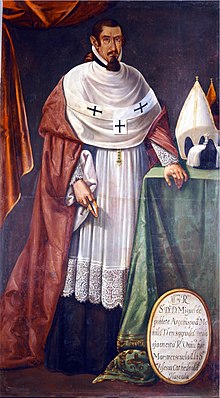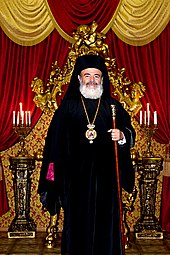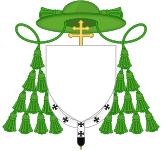Archbishop
| Part ofa serieson |
| Christianity |
|---|
 |
InChristian denominations,anarchbishopis abishopof higher rank or office. In most cases, such as theCatholic Church,there are many archbishops who either have jurisdiction over anecclesiastical provincein addition to their ownarchdiocese(with some exceptions), or are otherwise granted atitular archbishopric.In others, such as theLutheranChurch of Sweden,the title is only borne by the leader of the denomination.
Etymology
[edit]The wordarchbishop(/ˌɑːrtʃˈbɪʃəp/) comes via theLatinarchiepiscopus.This in turn comes from theGreekαρχιεπίσκοπος,which has as components the etymonsαρχι-, meaning 'chief',επί,'over', andσκοπός,'guardian, watcher'.[1][2][3]
Early history
[edit]The earliest appearance of neither the title nor the role can be traced. The title of "metropolitan" was apparently well known by the 4th century, when there are references in the canons of theFirst Council of Nicæaof 325 andCouncil of Antioch of 341,though the term seems to be used generally for all higher ranks of bishop, including patriarchs. The term "archbishop" does not appear in the modern sense until the 6th century, although the role, above ordinary bishops but below patriarchs, seems to be established for metropolitans by the 5th century.[4]
Western Christianity
[edit]
Metropolitan archbishops
[edit]Episcopal sees are generally arranged in groups in which one see's bishop has certain powers and duties of oversight over the others. He is known as the metropolitan archbishop of that see. In theCatholic Church,canon 436 of the Code of Canon Lawindicates what these powers and duties are for aLatin Churchmetropolitan archbishop, while those of the head of an autonomous (sui iuris)Eastern Catholic Churchesare indicated incanon 157of theCode of Canons of the Eastern Churches.All Catholic metropolitans are archbishops, but not all archbishops are metropolitans, though most are.
Non-metropolitan archiepiscopal sees
[edit]
As well as the much more numerous metropolitan sees, there are 77 Catholic sees that have archiepiscopal rank.[5]: 1142 In some cases, such a see is the only one in a country, such asLuxembourg[5]: 423 orMonaco,[5]: 474 too small to be divided into several dioceses so as to form an ecclesiastical province. In others, the title of archdiocese is for historical reasons attributed to a see that was once of greater importance.
Some of these archdioceses aresuffragansof a metropolitan archdiocese; examples are theArchdiocese of Avignon,which is a suffragan of theArchdiocese of Marseille,[6]and theArchdiocese of Trnava,Slovakia.Others are immediately subject to the Holy See and not to any metropolitan archdiocese. These are usually "aggregated" to an ecclesiastical province. An example is theArchdiocese of HobartinAustralia,associatedwith the Metropolitanecclesiastical province of Melbourne,but notpartof it.[5]: 296 The ordinary of such an archdiocese is an archbishop.
In theAnglican Communion,non-metropolitan archiepiscopal sees are much less common. TheAnglican Diocese of Jerusalem,established in 1841, was raised to the status of a non-metropolitan archiepiscopal see in 1957, but reduced to the status of an ordinary bishopric again in 1976. In 2014 it was again elevated to the status of non-metropolitan archbishopric, with its ordinary bearing the title "Archbishop in Jerusalem", despite having no ex officio right to be the metropolitan of the province.[7][8]
Coadjutor archbishops
[edit]Until 1970, a coadjutor archbishop, one who has special faculties and the right to succeed to the leadership of a see on the death or resignation of the incumbent,[9]was assigned also to atitular see,which he held until the moment of succession. Since then, the title of Coadjutor Archbishop of the see is considered sufficient and more appropriate.
Archbishopsad personam
[edit]The rank of archbishop is conferred on some bishops who are not ordinaries of an archdiocese. They hold the rank not because of the see that they head but because it has been granted to them personally (ad personam). Such a grant can be given when someone who already holds the rank of archbishop is transferred to a see that, though its present-day importance may be greater than the person's former see, is not archiepiscopal. The bishop transferred is then known as the archbishop-bishop of his new see. An example isGianfranco Gardin,appointed Archbishop-Bishop ofTrevisoon 21 December 2009.[10]The title borne by the successor of such an archbishop-bishop is merely that of Bishop of the see, unless he also is granted the personal title of Archbishop. Another example isArthur Roche,who wasBishop of Leedsuntil his appointment asSecretary of the Congregation for Divine Worship and the Discipline of the Sacraments.Roche remained a bishop by virtue of his position as bishop emeritus of Leeds – rather than being transferred to a different titular archbishopric, he was appointed as an archbishopad personam.
Titular archiepiscopal sees
[edit]The distinction between metropolitan sees and non-metropolitan archiepiscopal sees exists fortitular seesas well as for residential ones. TheAnnuario Pontificiomarks titular sees of the former class with the abbreviationMetr.and the others withArciv.[5]: 819
Many of the titular sees to whichnunciosand heads of departments of the Roman Curia who are not cardinals are assigned are not of archiepiscopal rank. In that case the person who is appointed to such a position is given the personal title of archbishop (ad personam). They are usually referred to as archbishop of the see, not as its archbishop-bishop.
Archbishops emeriti
[edit]If an archbishop resigns his see without being transferred to another, as in the case of retirement or assignment to head a department of theRoman Curia,the wordemeritusis added to his former title, and he is called archbishop emeritus of his former see. Until 1970, such archbishops were transferred to a titular see.
There can be several archbishops emeriti of the same see: the 2008Annuario Pontificiolisted three living archbishops emeriti ofTaipei.[11]
There is no archbishop emeritus of a titular see; an archbishop who holds a titular see keeps it until death or until transferred to another see.
In theAnglican Communion,retired archbishops formally revert to being addressed as "bishop" and styled "The Right Reverend",[12]although they may be appointed "archbishop emeritus" by their province on retirement, in which case they retain the title "archbishop" and the style "The Most Reverend", as a right.[13]ArchbishopDesmond Tutuwas a prominent example, as archbishop emeritus of Cape Town. Former archbishops who have not received the status of archbishop emeritus may still be informally addressed as "archbishop" as a courtesy,[14]unless they are subsequently appointed to a bishopric (not anarchbishopric), in which case the courtesy ceases.[15]
Privileges of archbishops
[edit]While there is no difference between the official dress of archbishops, as such, and that of other bishops, Roman Catholic metropolitan archbishops are distinguished by the use in liturgical ceremonies of thepallium,but only within the province over which they have oversight.[16]
Roman Catholic bishops and archbishops are styled "The Most Reverend" and addressed as "Your Excellency" in most cases. InEnglish-speakingcountries (except the United States), a Catholic archbishop is addressed as "Your Grace", while a Catholic bishop is addressed as "Your Lordship". Before December 12, 1930, the title "Most Reverend" was only for archbishops, while bishops were styled as "Right Reverend".[17]This practice is still followed by Catholic bishops in theUnited Kingdomto mirror that of theChurch of England.
In Roman Catholicheraldry,an archbishop has an ecclesiastical hat called agalerowith ten tassels on each side of hiscoat of arms,while a bishop has only six. The archiepiscopal cross behind the shield has two bars instead of one. Such a cross may be borne before him in liturgical processions.
In processions and other occasions where strict protocol is observed, archbishops are ranked higher thandiocesan bishopsin theorder of precedence.
In theAnglican Communion,archbishops are styled "The Most Reverend" and addressed as "Your Grace", while bishops are styled "The Right Reverend" and addressed as "My Lord" or "Your Lordship". (In some countries, this usage is followed also by the Roman Catholic Church, but in others no distinction is made and "The Most Reverend" and "Your Excellency" are used for archbishops and bishops alike.) Anglican archbishops are entitled to be preceded by a server carrying an archiepiscopal processional cross (with two bars instead of one) in liturgical processions.[18]Thearchbishop of Canterbury's metropolitical processional cross is always carried before him by a priest-chaplain, and (like other archbishops) is a two-barred processional cross. However, the archbishop of Canterbury is also entitled to be preceded by the ancient primatial cross of Canterbury (still in ceremonial use) which is of an ornate historical design, made of precious metal, and with precious stones inserted, but unlike his metropolitical cross (or those of other archbishops) it is not double-barred.[19]
Eastern Christianity
[edit]
Archbishops exist in all traditional denominations of theEastern Christianity,including theEastern Orthodox Church,theOriental Orthodox Churches,theEastern Catholic Churchesand others.
Eastern Orthodox Church
[edit]In the Eastern Orthodox churches, the office and title of archbishop can be traced from the 4th and 5th century. Historically, the title was used variously, in terms of rank and jurisdiction.[20]
In some Eastern Orthodox churches, archbishops are ranked abovemetropolitansinprecedence,while in others that order is reversed. Primates ofautocephalousEastern Orthodox churches belowpatriarchalrank are generally designated as archbishops. In theGreek Orthodox Church,archbishops are ranked above metropolitans inprecedence.The reverse is true for some Slavic Orthodox churches (Russian Orthodox,Bulgarian Orthodox) and also forRomanian Orthodox Church,where metropolitans rank above archbishops.
In terms of jurisdiction, there are two basic types of archbishops in the Eastern Orthodox Church: real archbishops and honorary archbishops. Real archbishops are primates of autocephalous or autonomous (regional) churches, and they have actual jurisdiction over other bishops, while honorary archbishops are in fact justdiocesan bishopswith honorary titles of archbishops and no jurisdiction outside their own diocese. The honorary title is usually conferred to bishops of historically importantsees.For example, in theSerbian Orthodox Church,both types were represented: the head of the autonomousOrthodox Ohrid Archbishopricis styledArchbishop of Ohridand invested with regional jurisdiction over all diocesan bishops inNorth Macedonia,while former diocesan bishop (lateAmfilohije Radović) of theEparchy of Montenegro and the Littoral,with seat inCetinje,was personally given only the honorary titleArchbishop of Cetinje,but without any jurisdiction over other diocesan bishops inMontenegro.[21]
Historically, within thePatriarchate of Constantinople,honorary archiepiscopal titles were also granted to those diocesan bishops who were exempt from jurisdictions of local metropolitans, and transferred to the direct jurisdiction of the patriarchal throne. Such titular hierarchs were contentiously styled as "autocephalous archbishops"(self-headed, just in terms of not having a metropolitan, but without connotations to realautocephaly).[22]For example, until the end of the 8th century, bishop ofAmoriumwas under the jurisdiction of metropolitan ofPessinus,but he was later exempt and placed under direct patriarchal jurisdiction. On that occasion, he was given an honorary title of anautocephalous archbishop,but with no jurisdiction over other bishops. Sometime later (c. 814), metropolitan province of Amorium was created, and local archbishop finally gained regional jurisdiction as a metropolitan.[23]
Oriental Orthodox Churches
[edit]TheOriental Orthodoxcustom generally agrees with the Slavic rather than the Greek with respect to the archbishop/metropolitan distinction.
Eastern Catholic Churches
[edit]Instead of the termarchbishop,Eastern Catholic Churchessometimes use the wordarcheparchby analogy witheparch,the term used for a diocesan (or eparchial) bishop. However, the wordarcheparchis not found in theCode of Canons of the Eastern Churches.[24]
See also
[edit]References
[edit]- ^ἀρχιεπίσκοπος,ἐπίσκοπος.Liddell, Henry George;Scott, Robert;A Greek–English Lexiconat thePerseus Project.
- ^archiepiscopus.Charlton T. Lewis and Charles Short.A Latin DictionaryonPerseus Project.
- ^"archbishop".Online Etymology Dictionary.
- ^Messmer, Sebastian Gebhard (1907)..In Herbermann, Charles (ed.).Catholic Encyclopedia.Vol. 1. New York: Robert Appleton Company.
- ^abcdeAnon. (2012).Annuario pontificio.Vatican City: Libreria Editrice Vaticana.ISBN978-88-209-8722-0.
- ^"Avignon (Latin (or Roman) Archdiocese) [Catholic-Hierarchy]".www.catholic-hierarchy.org.Retrieved2019-06-14.
- ^"A Brief History of the Diocese of Jerusalem".The Jerusalem and the Middle East Church Association.Retrieved26 June2020.
- ^"Archbishop in Jerusalem".Anglican Communion. 17 June 2020.Retrieved26 June2020.
- ^"Code of Canon Law: text - IntraText CT".www.intratext.com.Retrieved2019-06-14.
- ^"Friars Minor Conventual - Naming of the Archbishop-Bishop of Treviso, Italy".www2.ofmconv.pcn.net.Archived fromthe originalon 2021-05-13.Retrieved2019-06-14.
- ^Annuario Pontificio2008, p. 733
- ^"Addressing the Clergy".Church of England website.Archived fromthe originalon 2011-11-17.
See note 3
- ^See the example ofArchbishop David Moxon,for example.
- ^See "How to address the Clergy" inCrockford Clerical Directory, section "Archbishops", subsection "Notes".
- ^See final notes on the Archbishops page ofDebrettsforms of address.
- ^"Code of Canon Law: text - IntraText CT".www.intratext.com.Retrieved2019-06-14.
- ^Canon Law Digest,Bouscaren, Vol. 1, Page 20.Rt. Rev. Dominic Laurence GraesselArchived2013-02-05 at theWayback Machine.Roman Catholic Archdiocese of Baltimore.Retrieved on 2016-11-19.
- ^This Anglicannews agency page[permanent dead link]has photographs of two-barred crosses being carried by Archbishop George Carey and by Presiding Bishop Frank Griswold.
- ^The primatial cross is illustrated at theLondon SE1community website.
- ^Meyendorff 1989.
- ^SOC (2020)> Metropolitan Amfilohije of Montenegro and the Littoral reposed in the Lord
- ^Chrysos 1969,p. 263-286.
- ^Komatina 2013,p. 195-214.
- ^"CCEO: Alphabetical: A - IntraText CT".www.intratext.com.Retrieved2019-06-14.
Sources
[edit]- Chrysos, Evangelos K. (1969)."Zur Entstehung der Institution der autokephalen Erzbistümer".Byzantinische Zeitschrift.62(2): 263–286.doi:10.1515/bz-1969-0204.S2CID194081942.
- Komatina, Predrag (2013)."Date of the Composition of the Notitiae Episcopatuum Ecclesiae Constantinopolitanae nos. 4, 5 and 6"(PDF).Зборник радова Византолошког института.50(1): 195–214.Archived(PDF)from the original on 2016-12-27.
- Meyendorff, John(1989).Imperial unity and Christian divisions: The Church 450-680 A.D.The Church in history. Vol. 2. Crestwood, NY: St. Vladimir's Seminary Press.ISBN9780881410563.
- Phillips, Walter Alison(1911)..Encyclopædia Britannica.Vol. 2 (11th ed.). pp. 356–358.



